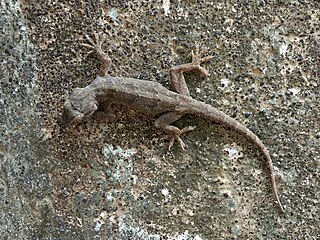
Hemidactylus is a genus of the common gecko family, Gekkonidae. It has 168 described species, newfound ones being described every few years. These geckos are found in all the tropical regions of the world, extending into the subtropical parts of Africa and Europe. They excel in colonizing oceanic islands by rafting on flotsam, and are for example found across most of Polynesia. In some archipelagoes, cryptic species complexes are found. Geckos like to live in and out of houses. They have been introduced to Australia.

Gekkoninae is a diverse subfamily of the family Gekkonidae, geckos. It has the most species and genera — over 850 species in 30 genera. Hemidactylus and Cyrtodactylus together account for 185 species.

Hemidactylus brookii, commonly known as Brooke's house gecko or spotted house gecko, is a widespread species of gecko.

The Indo-Pacific gecko also known as Garnot's house gecko, the fox gecko, or the Assam greyish brown gecko, is a species of gecko found in India, the Philippines, Southeast Asia, Australia, and throughout Polynesia. Adults are about 4 to 5 in in total length. They are seen as dark gray or brown with light markings in daylight and a pale, translucent colour at night. The belly is orange or yellow. The head has a long, narrow snout, hence the name fox gecko. The flattened tail has a row of spiny scales on the lateral edges. The species is parthenogenic – all individuals are female and lay eggs that hatch without requiring male fertilisation.

Leschenault's leaf-toed gecko is a species of gecko, a lizard in the family Gekkonidae. The species is endemic to South Asia and parts of West Asia. It is often found inside homes. Its scientific name commemorates French botanist Jean Baptiste Leschenault de la Tour.

The Mediterranean house gecko is a type of house gecko common to the Mediterranean area which has spread to many parts of the world. It is commonly referred to as the Turkish gecko as represented in its Latin name and also as the moon lizard because it emerges in the evening.

The tropical house gecko, Afro-American house gecko or cosmopolitan house gecko is a species of house gecko native to sub-Saharan Africa. It is also currently found in North, Central and South America and the Caribbean, where it has been inadvertently introduced by humans.

The common house gecko, is a gecko native to Southeast Asia. It is also known as the Asian house gecko, Pacific house gecko, wall gecko, house lizard, or moon lizard.

The Mount Sinai gecko is a species of lizard in the family Gekkonidae. The species is endemic to Egypt.

The carrot-tail viper gecko is a species of gecko. It is found in Pakistan and possibly India, although the Indian records are questionable.

The Antilles leaf-toed gecko, also known as the Maria Islands leaf-toed gecko or spiny gecko, is a gecko species found in northern South America, where it is restricted to lowland areas. It can also be found on small rocks and islets offshore of Saint Lucia, Trinidad, and Tobago, though it is absent from the main islands.
Coleophora asirensis is a moth of the family Coleophoridae that is endemic to Saudi Arabia.
Hemidactylus bouvieri, also known as Bouvier's leaf-toed gecko or Cape Verde leaf-toed gecko, is a species of gecko in the family Gekkonidae. The species is endemic to the Cape Verde Islands and is listed as critically endangered. It has been found on the islands of São Vicente, Santo Antão, Santa Luzia, São Nicolau, Santiago and Ilhéu Raso.
The Asir magpie, also known as the Arabian magpie, is a highly endangered species of magpie endemic to Saudi Arabia. It is only found in the country's southwestern highlands, in the Asir Region. It occurs only in African juniper forest in well-vegetated wadis and valleys. It was formerly classified as a subspecies of the Eurasian magpie, and still is by many authorities. This species is highly threatened by habitat destruction, as its native forests are not regenerating. Tourism development and climate change are also posing a threat. Only 135 pairs are known to survive in the wild, and this number is declining.
Hemidactylus ruspolii, also known commonly as the farm leaf-toed gecko, Prince Ruspoli's gecko, Ruspoli's gecko, and the turnip-tailed black and yellow gecko, is a species of lizard in the family Gekkonidae. The species is endemic to northern East Africa.

Hemidactylus yerburyi, also known as Yerbury's gecko or Yerburi's leaf-toed gecko, is a species of gecko. It is found on the southern Arabian Peninsula in Yemen and Saudi Arabia. Populations reported from Africa are based on misidentifications or have been elevated from subspecies to full species rank, namely Hemidactylus pauciporosus. Hemidactylus yerburyi is named after Colonel Yerbury who saw and/or collected the species.
Treutler's gecko is a species of lizard in the family Gekkonidae. The species is endemic to India.










